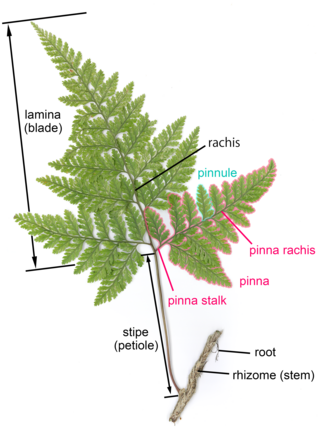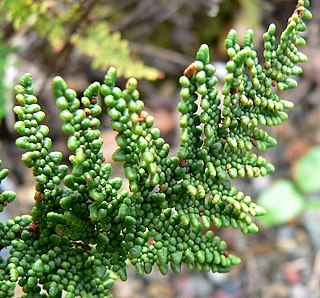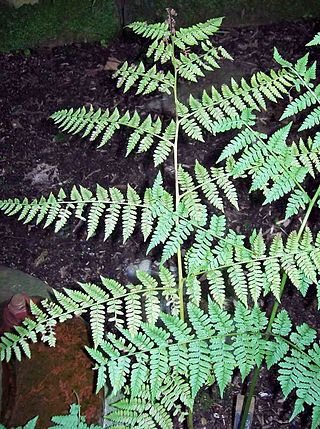
A frond is a large, divided leaf. In both common usage and botanical nomenclature, the leaves of ferns are referred to as fronds and some botanists restrict the term to this group. Other botanists allow the term frond to also apply to the large leaves of cycads, as well as palms (Arecaceae) and various other flowering plants, such as mimosa or sumac. "Frond" is commonly used to identify a large, compound leaf, but if the term is used botanically to refer to the leaves of ferns and algae it may be applied to smaller and undivided leaves.

Cyathea affinis is a variable species of tree fern native to Fiji, Samoa, the Cook Islands, Austral Islands, Tahiti, and the Marquesas Islands. The trunk of this plant is erect and 2–6 m tall. Fronds are bipinnate and 2–3 m in length. The rachis and stipe are pale to brown in colour, or flushed with red towards the pinnule rachis. The stipe is sparsely covered in narrow basal scales, which are pale to dark and have broad fragile edges. Characteristically of this species, the lowest one or two pairs of pinnae may be slightly reduced and occur towards the base of the stipe. Sori are located near the pinnule midvein and are partially or fully covered by indusia, which open towards the pinnule margin.
Gymnosphaera andersonii, synonyms Alsophila andersonii and Cyathea andersonii, is a species of tree fern native to the eastern Himalayas of India, Bhutan, and Tibet, Myanmar, and south-central China, where it grows in moist valleys and montane forest at an elevation of 300–1200 m. The trunk is erect and 6–10 m tall. Fronds are bi- or tripinnate and 2–3 m long. The entire plant is relatively dark in appearance; the rachis is flushed with dark purple and the stipe is dark, almost to the point of being black. Dark, lanceolate scales with pale fringes are sparsely scattered along the length of the stipe. Sori occur near the midvein of fertile pinnules and lack indusia.
Gymnosphaera baileyana, synonyms Alsophila baileyana and Cyathea baileyana, also known as the wig tree fern, is a species of tree fern native to northeastern Queensland in Australia, where it grows in wet gullies and forest at an elevation of 850–1200 m. It is a rare species that is seldom found in the wild. The erect trunk is 4–5 m tall, approximately 10 cm in diameter and may be covered in stipe bases in the upper regions. C. baileyana is notable for being able to develop offshoots from the base of the trunk. Fronds are bi- or tripinnate and may be exceptionally long, up to 7 m, though they are usually around 2–3 m. The rachis and stipe are dark to darkish red, scaly and may be warty, but lack spines. Scales on the rachis and stipe are purplish brown to black and have a long hair-like apex. Characteristically of this species, the last pair of pinnae are separated from the others along the rachis and may form a clump around the trunk apex. Sori are circular and occur in one to three rows along the pinnule midvein. They lack indusia.

Gymnosphaera capensis, synonyms Alsophila capensis and Cyathea capensis, is a regionally widespread and highly variable species of tree fern. It is indigenous to Southern Africa and South America.

Cyathea corcovadensis is a species of tree fern native to Paraguay and Serra do Mar in southern Brazil, where it grows in primary and secondary forest, as well as scrub, at an altitude of 250–2100 m. The erect trunk is short, usually about 30–60 cm tall. Fronds are bipinnate and 2.5 m or more in length. The rachis ranges in colour from brown to purplish and is covered with warts and scattered brown scales. Sori occur either between the fertile pinnule midvein and the edge of the lamina or just beside the midvein. They lack indusia. C. corcovadensis is a variable species, especially in terms of pinnule shape and degree of dissection.
Alsophila imrayana, synonym Cyathea imrayana, is a species of tree fern native to Dominica, Costa Rica, Panama, Venezuela, and Ecuador.

Dennstaedtia is a mostly tropical and subtropical group of ferns described as a genus in 1801. Hayscented fern, or cup ferns, are common names for some species in this genus. It includes 58 species native to the tropical Americas, Madagascar, southern and eastern Asia, Australia, New Guinea, and the Pacific Islands.

Myriopteris clevelandii, formerly known as Cheilanthes clevelandii, is a species of lip fern known by the common name Cleveland's lip fern. It is native to southern California and Baja California in Mexico. The leaf is divided into small, bead-like segments densely covered with scales beneath. In M. clevelandii, some of these scales are reduced to hairlike structures, which help distinguish it from the closely related M. covillei. It is usually found growing on exposed rock, particularly igneous rock.

Diplazium australe, commonly known as the Austral lady fern, is a small fern occurring in eastern Australia, New Zealand and Norfolk Island. The habitat is moist shaded areas, often occurring in rainforest.

Gleichenia microphylla is a small fern growing in Australia and New Zealand.

Adiantum viridimontanum, commonly known as Green Mountain maidenhair fern, is a fern found only in outcrops of serpentine rock in New England and Eastern Canada. The leaf blade is cut into finger-like segments, themselves once-divided, which are borne on the outer side of a curved, dark, glossy rachis. These finger-like segments are not individual leaves, but parts of a single compound leaf. The "fingers" may be drooping or erect, depending on whether the individual fern grows in shade or sunlight. Spores are borne under false indusia at the edge of the subdivisions of the leaf, a characteristic unique to the genus Adiantum.

Myriopteris alabamensis, the Alabama lip fern, is a moderately-sized fern of the United States and Mexico, a member of the family Pteridaceae. Unlike many members of its genus, its leaves have a few hairs on upper and lower surfaces, or lack them entirely. One of the cheilanthoid ferns, it was usually classified in the genus Cheilanthes as Cheilanthes alabamensis until 2013, when the genus Myriopteris was again recognized as separate from Cheilanthes. It typically grows in shade on limestone outcrops.
Myriopteris aemula, the Texas lip fern or rival lip fern, is a moderately-sized fern of Texas and Mexico, a member of the family Pteridaceae. Unlike many members of its genus, its leaves have a few hairs on upper and lower surfaces, or lack them entirely. One of the cheilanthoid ferns, it was usually classified in the genus Cheilanthes as Cheilanthes aemula until 2013, when the genus Myriopteris was again recognized as separate from Cheilanthes. It typically grows on limestone rock.
Myriopteris allosuroides is a moderately-sized fern of Mexico, a member of the family Pteridaceae. Unlike many members of its genus, its rachides are grooved on the upper surface and largely free of hairs or scales. One of the cheilanthoid ferns, it was usually classified in the genera Cheilanthes or Pellaea until 2013, when the genus Myriopteris was again recognized as separate from Cheilanthes. It typically grows on dry, rocky slopes over acidic, particularly basaltic, rock.
Argyrochosma connectens is a small cheilanthoid fern endemic to Sichuan, China. It is the only member of its genus known from Asia. Relatively rare, it is found growing in the crevices of limestone rocks in hot, dry valleys. The species was long classified in the genus Pellaea, but after a phylogenetic study in 2015 was transferred to Argyrochosma.
Argyrochosma lumholtzii is a rare fern in the family Pteridaceae known from Sonora, Mexico. It is quite similar to Jones' false cloak fern, but has black leaf axes and a less highly divided leaf. First described as a species in 1939, honoring the explorer Carl Sofus Lumholtz, it was transferred to the new genus Argyrochosma in 1987, recognizing their distinctness from the "cloak ferns".
Myriopteris cinnamomea is a Central American fern. It is very similar to M. mickelii of southern Mexico and to other species in the "alabamensis clade" of Myriopteris. It is modestly sized, with leaves not more than 30 centimeters (12 in) long. They are divided into pinnae, which in turn are divided into lobed pinnules, and covered with pale brown hairs on the underside.
Myriopteris mickelii is a fern endemic to southern Mexico. It is very similar to M. cinnamomea of Central America, from which it was separated when described in 1980, and to other species in the "alabamensis clade" of Myriopteris. Named after the pteridologist John T. Mickel, it grows on dry, lightly shaded slopes and banks.
Hymenophyllum axsmithii is an extinct species of fern in the family Hymenophyllaceae related to the modern hayscented ferns. The species is known from fossil fronds found in early Eocene sites of northern Washington state, United States and central British Columbia, Canada. The species is included in Hymenophyllum subgenus Sphaerocionium, with a suggested to be closest to a group of tropical species in the subgenus that are all specialized as sheltered epiphytes.










